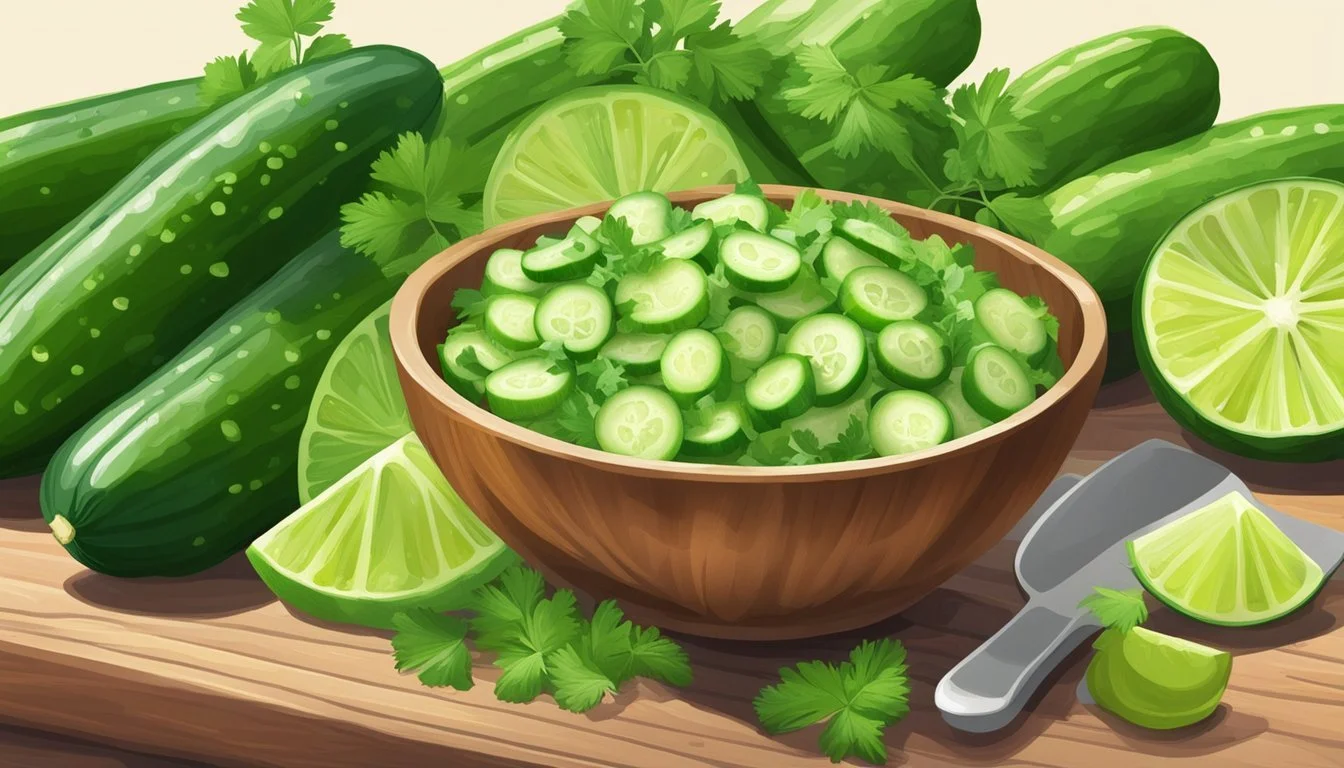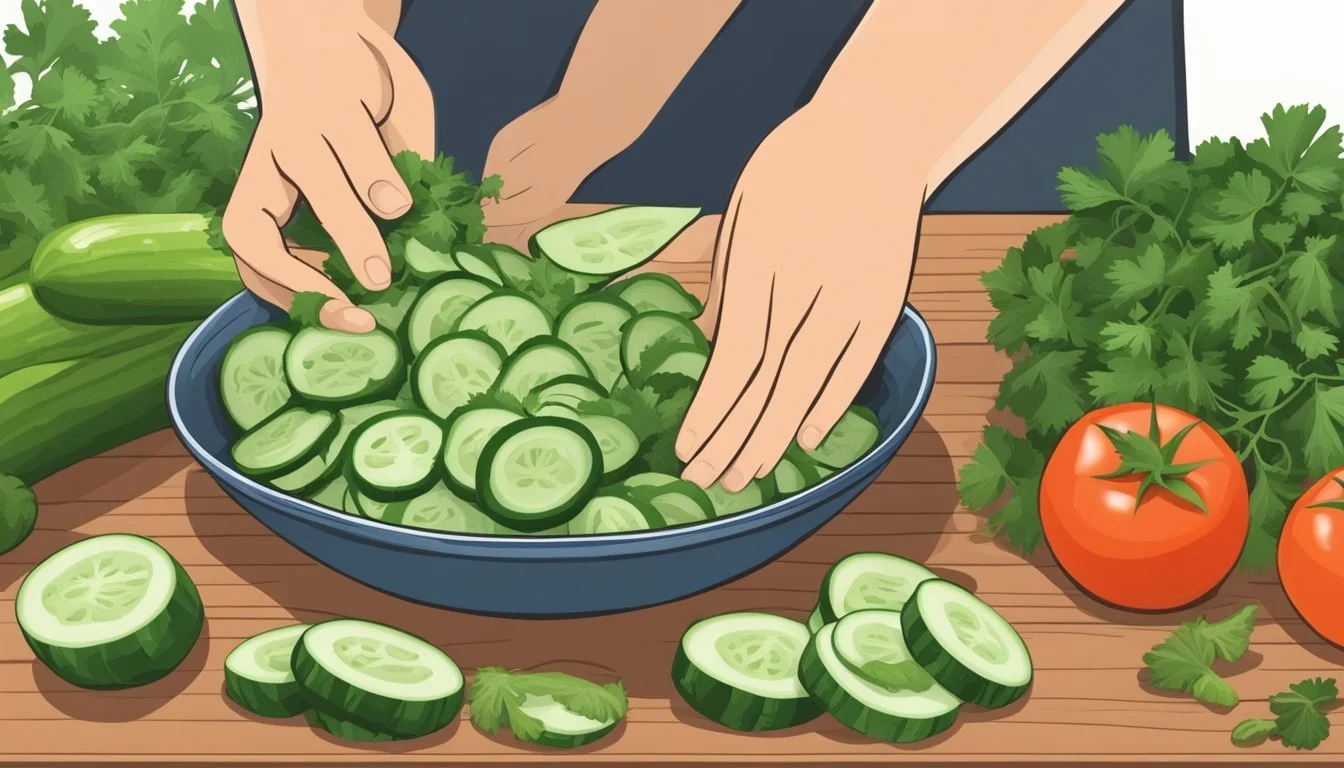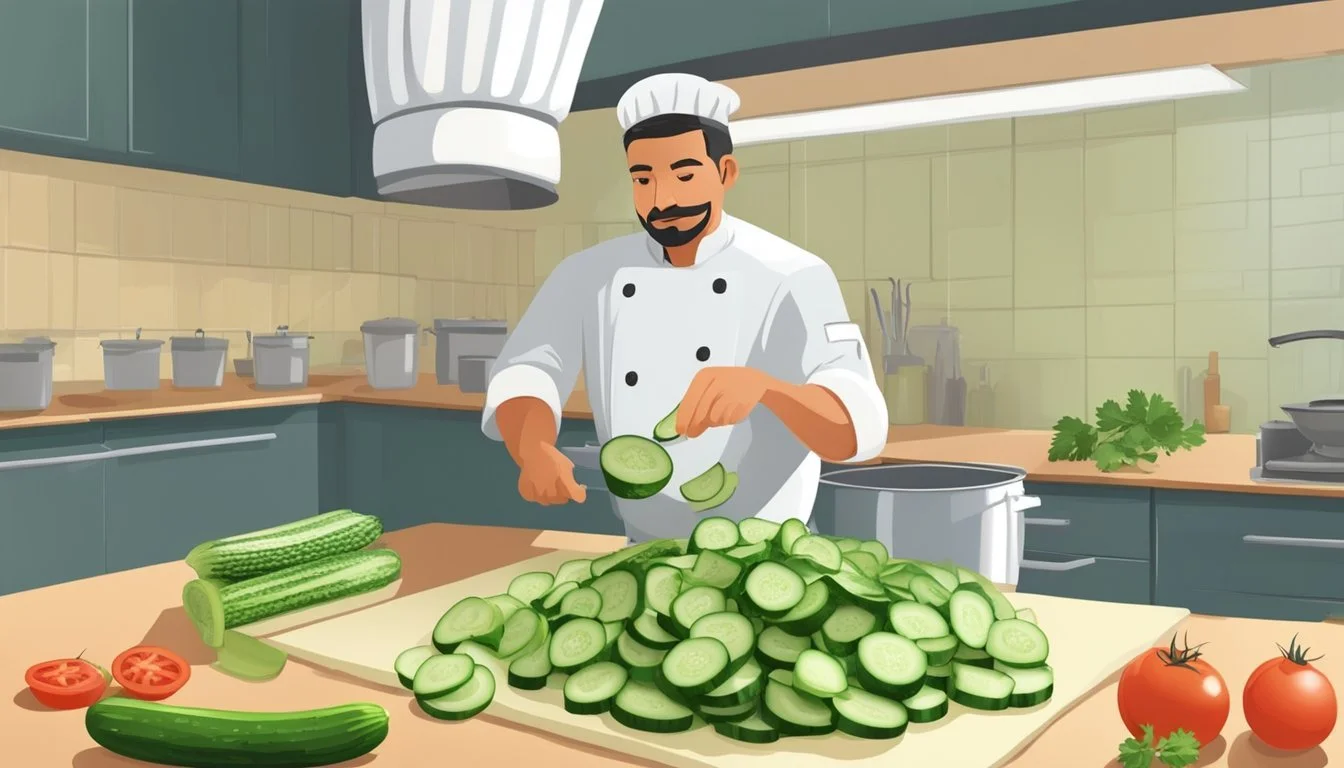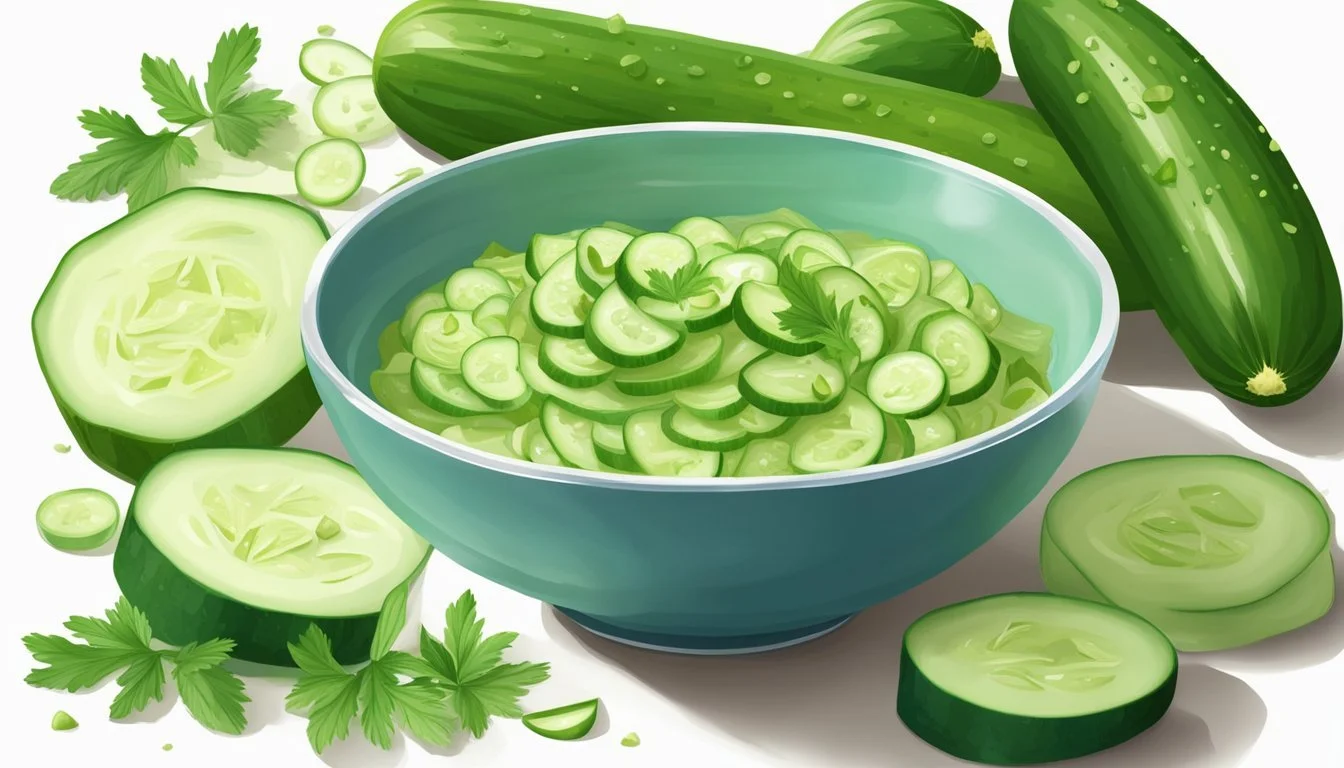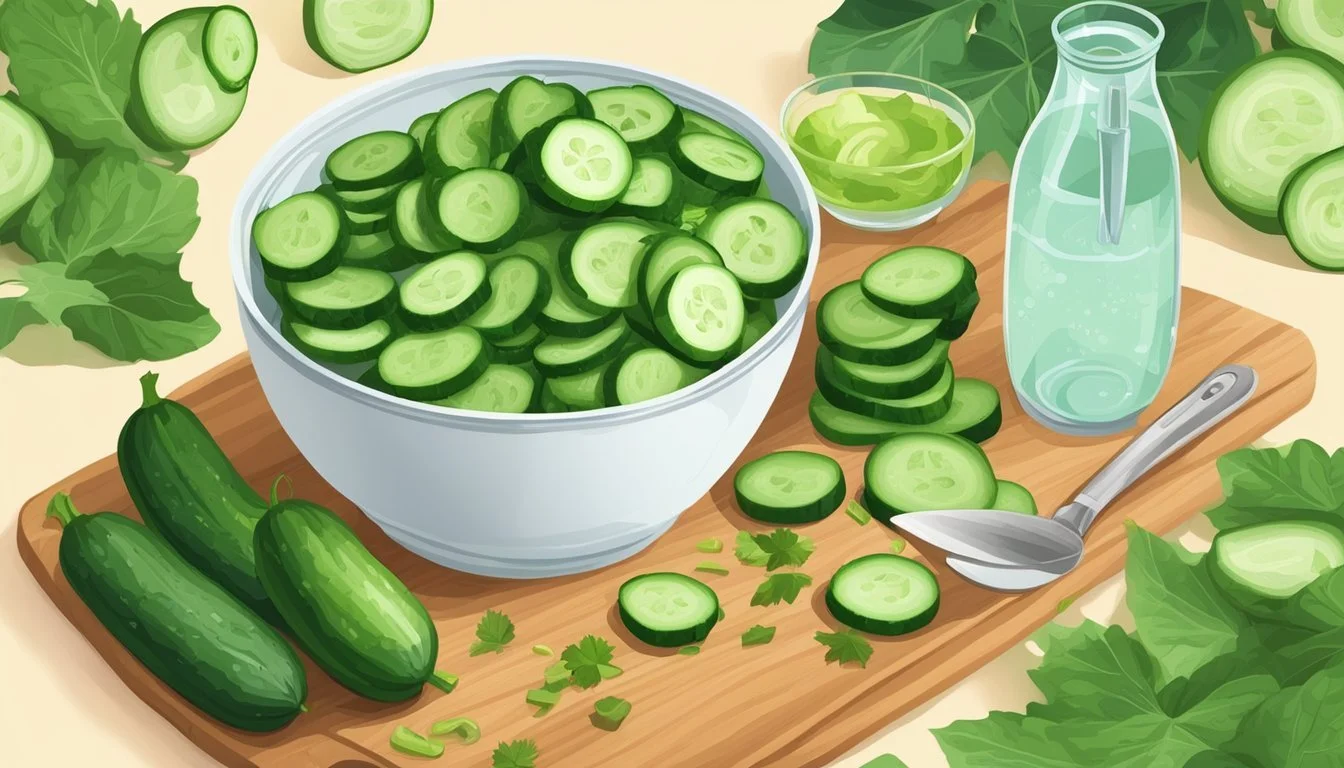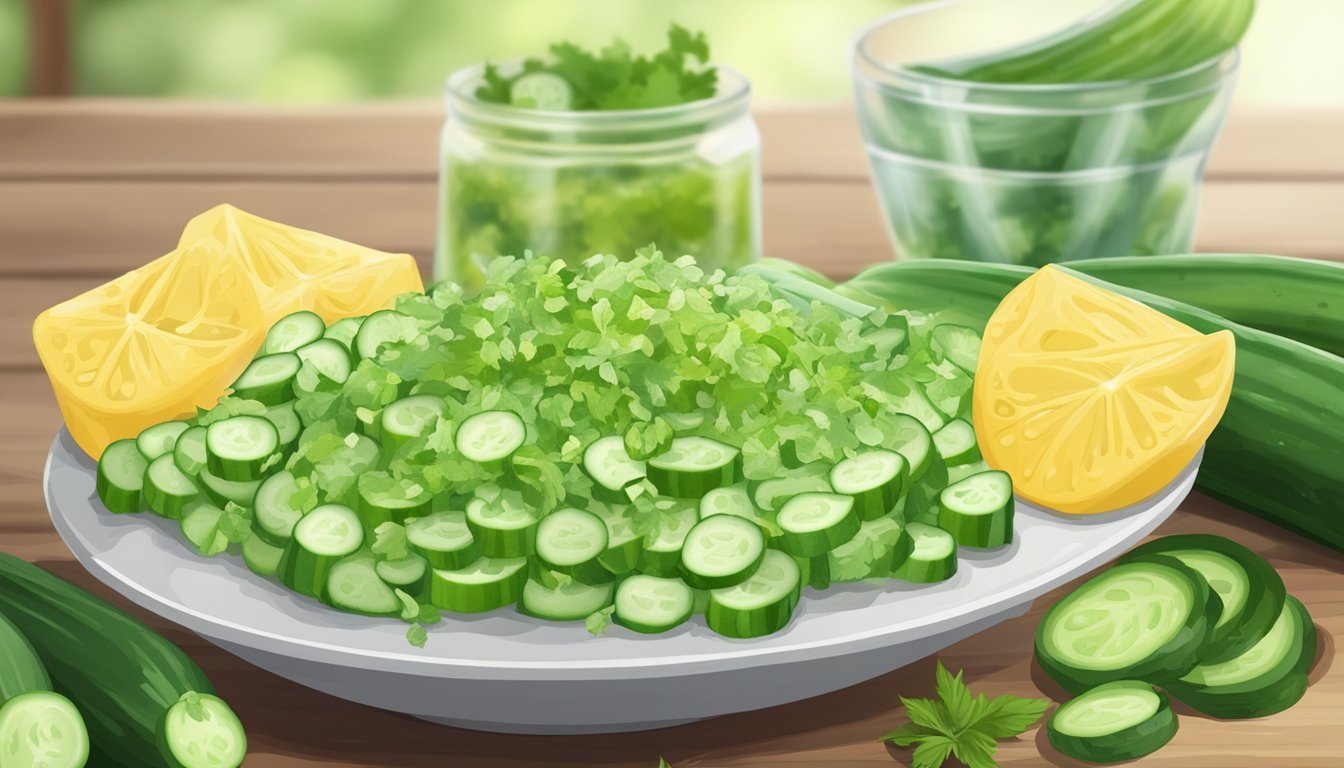Cucumber Peel Salsa
A Refreshing, Hydrating Condiment for Summer Feasts
Cucumber Peel Salsa offers a new twist on a traditional condiment, providing not only a burst of flavor but also a considerable dose of hydration. Ideal for those looking to add a refreshing touch to their meals, this salsa capitalizes on the crisp texture and subtle sweetness of cucumber peels. This incorporation of a typically discarded part of the vegetable ensures that the salsa is not only packed with essential nutrients but also aligns with a waste-reducing approach to cooking.
The recipe for Cucumber Peel Salsa is simple yet adaptable, allowing for a range of ingredients such as ripe tomatoes, onions, (What wine goes well with onions?) and zesty jalapeños to mingle with the cucumber peels. Lime juice and a splash of olive oil round out the flavor profile, creating a condiment that is as hydrating as it is flavorful. This salsa serves as the perfect accompaniment to a variety of dishes, from grilled fish to crunchy tortilla chips, and is versatile enough to be tweaked according to taste.
Developing a salsa that is innovative in its use of ingredients while still delivering on taste and refreshment is a testament to modern, health-conscious cooking. Cucumber Peel Salsa is poised to become a go-to for adding a quick and hydrating zing to any meal without compromising on nutritional value. This condiment is more than just a side; it's an expression of culinary creativity.
Health Benefits of Cucumber Salsa
Cucumber salsa offers a range of health benefits, making it both a delicious and nutritious choice for those seeking a refreshing condiment.
Hydration: Cucumbers are known for their high water content, which aids in hydration. A serving of cucumber salsa can provide a hydrating boost, especially on hot days or after a workout.
Nutrition Information:
Calories: It is low in calories, making it a healthy addition to any meal.
Fiber: With cucumbers as a primary ingredient, this salsa is a good source of dietary fiber, important for digestive health.
Vitamin C: Cucumbers contain vitamin C, an antioxidant that supports the immune system.
Potassium: This mineral, found in cucumbers, is beneficial for heart health and maintaining healthy blood pressure levels.
Ingredients and Nutritional Value
Cucumber: A source of vitamin C, potassium, and hydration.
Tomatoes: Provides additional vitamin C and fiber.
Onions: Offer fiber and flavonoids with antioxidant properties.
Cilantro: Contains vitamins A and K, and antioxidants.
Eating cucumber salsa can be a healthy choice due to its combination of vegetables, which contribute essential nutrients while keeping the calorie count low. Its fiber content supports digestive health, while the potassium and vitamin C content promote overall well-being. Additionally, cucumber salsa is a versatile topping that pairs well with various dishes, enhancing flavor without compromising nutritional value.
Selecting the Right Ingredients
Creating a delicious Cucumber Peel Salsa hinges on the freshness and quality of the ingredients. Each component should be chosen to ensure a balance of flavors and textures that complement each other.
Choosing the Best Cucumbers
For the most refreshing salsa, one should opt for English cucumbers. These are typically seedless, have a thin skin that's ideal for peeling, and are known for their crisp texture. Ensure the cucumbers are firm to the touch with a bright green color, indicating freshness.
Fresh Herbs for Enhanced Flavor
Fresh cilantro is essential for authentic flavor in salsa. The leaves should look vibrant and green without any signs of wilting, to contribute a fresh, citrusy note. To maximize flavor, it's best to chop the cilantro just before adding it to the salsa.
Tomato Varieties and Taste
Roma tomatoes are often the preferred choice for salsa due to their firm texture and lower water content, which helps prevent a watery salsa. They should be deep red and firm, with a slightly sweet taste that balances the acidity.
The Role of Onions and Garlic
The onions should bring a slight crunch and sharpness, which is why a red onion is typically preferred for its color and milder flavor. Garlic adds depth, and it's crucial to use fresh cloves for a pungent, aromatic quality. Both onions and garlic should be free of soft spots and sprouting.
Preparation and Cooking Tips
Creating a refreshing batch of cucumber peel salsa hinges on a few key preparation and cooking techniques. Attention to the peeling and chopping of ingredients ensures a desirable texture, while careful mixing and seasoning contribute to a well-balanced flavor profile. Here are some tips they'll need for a perfect salsa.
Proper Peeling and Chopping
Peeling: Keep the peel on if they prefer a more textured salsa, or peel the cucumber for a softer bite. If using organic cucumbers, the skin can add nutrients and a vibrant color.
Chopping: Consistency is crucial for even distribution of flavors. Dice the cucumber, onion, and any peppers uniformly, aiming for pieces that are small enough to scoop up with a chip but large enough to provide crunch.
Mixing Techniques for Best Texture
Gentle Tossing: Combine the diced cucumber with other ingredients like red pepper and onion in a bowl. Use a folding motion to mix, which helps the ingredients meld without becoming mushy.
Timing: Dress the salsa with lime juice and olive oil just before serving. This preserves the fresh texture and prevents sogginess.
Seasoning for a Balanced Taste
Acid and Zest: A splash of lime juice adds brightness while lime zest can intensify the flavor without adding more liquid. They should taste and tweak as they go.
Salt and Pepper: Season with salt and black pepper to enhance the natural flavors. They should start with a pinch, taste, and adjust.
Serving Suggestions
Pairing: Serve immediately with gluten-free, vegan, or keto-friendly options like tortilla chips or fresh veggies.
Storing: If they need to store it, place it in a refrigerated container for up to 4 days, though fresh is best to enjoy the crispness.
Following these tips, they can make a hydrating and flavorful cucumber peel salsa that complements a variety of dishes and dietary needs.
Salsa Pairing Ideas
Cucumber peel salsa offers a refreshing zest to a variety of dishes and snacks. It's a versatile condiment that brings both hydration and flavor to the table.
Complementing Dishes for Cucumber Salsa
Cucumber salsa pairs exceptionally well with a range of Mexican-inspired dishes. Tacos, whether filled with grilled chicken or seafood like salmon, are elevated with the addition of the salsa. The freshness of the cucumber salsa cuts through the richness, making it a perfect match. Additionally, this salsa can be a delicious topping for a simple grilled chicken salad, bringing a hydrating and tangy aspect to the greens.
Tacos: Grilled chicken, seafood (e.g., salmon), black beans
Salads: Leafy greens with grilled chicken, cherry tomatoes, and a light vinaigrette
Proteins: Grilled chicken breasts, salmon fillets, shrimp skewers
Snack and Dip Combinations
When it comes to snacking, cucumber salsa is a star. It serves as a hydrating dip alternative with an array of snacks, from tortilla chips to whole-grain crackers. Its crisp texture and refreshing taste make it a favorite for gatherings or a simple afternoon snack. For those who enjoy nachos, replacing the traditional salsa with cucumber salsa can transform the experience, adding a burst of freshness.
Chips and Crackers: Tortilla chips, pita chips, whole-grain crackers
Nachos: Layered with cheese, beans, and a spoonful of cucumber salsa
Cucumber peel salsa is not only a delightful accompaniment but also helps to enhance the overall flavor profile of these dishes and snacks.
Storing and Preserving Salsa
Proper storage methods are critical for maintaining the freshness and extending the shelf life of cucumber peel salsa. Utilizing airtight containers, adhering to refrigeration guidelines, and implementing freezer tips can significantly influence the quality and longevity of the salsa.
Airtight Containers for Freshness
To preserve cucumber peel salsa's vibrancy, airtight containers are essential. They prevent the salsa from absorbing fridge odors and limit exposure to air, which can lead to spoilage. When placing salsa in these containers, leave a small headspace at the top, as liquids expand when they freeze. For best results:
Use glass jars or plastic containers with tight-fitting lids.
Ensure the container is clean and dry before adding the salsa.
Refrigeration Guidelines
Refrigerating cucumber peel salsa slows bacterial growth and retains its freshness. The ideal temperature for storage is below 40°F (4°C) in the refrigerator. Consistent use of clean utensils helps to prevent cross-contamination which can degrade the salsa's quality.
Refrigeration shelf life: 2-3 days for optimal flavor.
Keep salsa in the coldest part of the refrigerator, away from the door.
Freezer Tips for Long-Term Storage
For those looking to keep cucumber peel salsa beyond a few days, freezing is a practical solution. While fresh salsa is best, freezing can preserve flavors for later use.
Store salsa in freezer-safe containers or bags, filling to about 80% capacity.
Remove excess air from bags before sealing to prevent freezer burn.
Label containers with the date; frozen salsa can last up to six months in the freezer.
Customizing Your Cucumber Salsa
Customizing cucumber salsa allows one to cater to individual palate preferences, ranging from fiery to mild, while introducing an array of textures and flavors.
Spicy or Mild: Adjusting the Heat
To adjust the heat level in cucumber salsa, the type of pepper used is key. For a mild salsa, one can use bell peppers, which provide a sweet, crunchy element without adding heat. For those who prefer a spicier kick, jalapeño peppers are a popular choice; seeding them will lessen their heat. For a more intense spice, incorporating poblano, habanero, or even smoky chipotle peppers will elevate the heat significantly.
Mild Options:
Bell pepper
Seeded jalapeño
Spicy Options:
Jalapeño (with seeds)
Poblano
Habanero
Chipotle (in adobo for extra smokiness)
Creative Add-Ins and Variations
The freshness of cucumber salsa can be augmented with a variety of add-ins. For a sweet note, one could introduce pomegranate seeds or diced mango, which contrasts delightfully with the savory components. Red onion can be soaked for a gentler flavor, or used raw for extra bite. To resemble a pico de gallo, increase the proportion of tomatoes and red onions.
To create a salsa that pairs well with enchiladas, consider adding corn and black beans for substantial texture. The creativity with cucumber salsa is boundless; one can mix and match flavors and textures to produce a condiment that is both hydrating and enriching to the palate.
Sweet Variations:
Pomegranate seeds
Mango
Pico de Gallo Style:
Increase tomatoes
Add red onion
Hearty Add-Ins (for enchiladas):
Corn
Black beans
Nutritional Profile
When examining the nutritional content of cucumber peel salsa, one finds a rich compilation of beneficial nutrients. The condiment is particularly notable for its fiber and hydration qualities, attributed to its primary ingredients.
Cucumbers, especially when unpeeled, are an excellent source of dietary fiber, which supports digestive health. A large cucumber with the peel provides roughly 2 grams of fiber, contributing to daily intake requirements.
Pomegranate seeds add not only a burst of flavor but also a decent amount of vitamin C, enhancing the salsa's nutritional value. Pomegranate seeds also contribute additional fiber to the dish, rounding out its textural profile and nutritional density.
Here is a succinct breakdown of the nutritional content:
Calories: Cucumber peel salsa is considered low in calories, making it a suitable addition to various diets.
Carbohydrates: It contains a moderate amount of carbohydrates, mainly from vegetables and fruits.
Sugars: Any sugar present is naturally occurring from the ingredients themselves, such as the pomegranate seeds.
Vitamin C: Ingredients like pomegranate seeds provide this essential nutrient, which is important for immune function and skin health.
Nutrition Information: A typical serving of salsa can provide a portion of one's daily nutritional needs, particularly in terms of vitamin K, mostly derived from cucumbers with their skins.
Incorporating cucumber peel salsa into one's diet offers a way to enjoy a flavorful condiment while also gaining various health benefits due to its nutrient-rich profile.
Food Safety and Handling
Proper food safety and handling are critical for creating a refreshing and hydrating Cucumber Peel Salsa that is not only dairy-free but also safe to consume. This section will cover essential practices from ingredient preparation to preventing cross-contamination.
Washing and Preparing Ingredients
When making Cucumber Peel Salsa, one must ensure all ingredients, especially the cucumber peels, are thoroughly washed under running water to remove any potential pesticides or bacteria. This step is indispensable as cucumber skins can harbor contaminants. Drying ingredients with a clean cloth or paper towel afterward is equally important to eliminate excess moisture.
Pomegranate seeds and cucumber, two primary ingredients, should be inspected to ensure that they are free from spoilage or deterioration. Removing seeds from fruits and vegetables should be done with care, using clean utensils to avoid incorporating any unwanted materials into the salsa.
Cross-Contamination Concerns
Cross-contamination can easily occur during the preparation of any food item, and in the context of Cucumber Peel Salsa, it's a concern that needs addressing.
Utensils and Surfaces: Always use separate cutting boards and knives for different types of ingredients—particularly when handling spicy items like jalapeños—to prevent the transfer of heat to other components of the salsa.
For example, cutting a cucumber after slicing a jalapeño without properly cleaning the knife can transfer capsaicin (the compound that makes chili peppers hot) to the cucumber, affecting the final taste of the salsa.
Raw vs. Cooked: Avoid using the same utensils and surfaces for both raw and cooked food.
By diligently following these protocols, one can prevent flavor alteration and ensure that the salsa remains a safe and enjoyable dairy-free condiment.
FAQs and Common Misconceptions
This section aims to dispel common myths and provide clarity on the benefits and preparation of cucumber salsa—a condiment that balances health with flavor.
Is Cucumber Salsa Truly Healthier?
Cucumber salsa is often touted as a healthier alternative to traditional salsas due to its high water content and low calories. It is made with simple ingredients such as fresh cucumbers, which are hydrating and packed with essential vitamins. When made with other nutritious items like onions and tomatoes, its nutrient profile is enhanced, making it a health-conscious choice.
Can I Make It Ahead of Time?
Many worry that cucumber salsa may not be suitable for making in advance, but it can be prepared ahead of time. To maintain its refreshing quality, it should be kept in an airtight container and refrigerated. This not only helps in keeping it fresh but also allows the flavors to meld, resulting in a more flavorful condiment. For optimal taste, one should aim to consume it within 2 days.
Is It Kid-Friendly?
Parents often question whether cucumber salsa is appropriate for children given its potential spiciness. The truth is that cucumber salsa can be very kid-friendly. By controlling the amount of spicy ingredients like jalapenos, it can be adapted to suit younger palates. Its refreshing and often tangy taste appeals to kids, especially when paired with mild tortilla chips or used as a topping for simple dishes.

